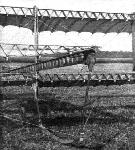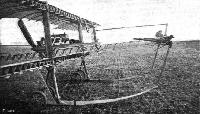L.Opdyke French Aeroplanes Before the Great War (Schiffer)
Deleted by request of (c)Schiffer Publishing
Paulhan
Although as a pilot the greatest prize-winner of his time, Louis Paulhan was a relatively unsuccessful constructor; his aeronautical work ended before World War II.
During his military service from 1905 to 1908, he was assigned to Chalais-Meudon, where he worked with Ferdinand Ferber. With Louis Peyret he built a series of large tandem monoplane models which marked the start of his career. At least one of them was about 4 m in span, the 2 pairs of wings with arched dihedral; 2 pusher propellers were mounted on outriggers between the wings. A forward elevator sat high above the boat-shaped hull.
He became the captain of Surcouf's dirigible Ville de Paris, and was a major contributor to the design of Kapferer's Astra monoplanes, the second of which resembled closely his big model. And his models won him a prize: a complete Voisin airframe. He christened it Octavie III; it was the first Gnome-powered aeroplane to fly.
In 1910 he started his aeroplane-building business in association with Henri Fabre, and in February 1911 built his "machine a voler" (flying machine); it was similar to the earlier Fabre seaplanes, but a biplane. Fabre girders were used as leading edges to which the wing coverings were laced, with battens loose in pockets every few inches: 2 more, but covered over, were used to carry the forward elevator and aft tailplane. 4 single struts separated the upper and lower wing girders. Shorter Fabre spars were used as leading edges of the other surfaces. A streamlined aluminum nacelle was supported between the wings and carried 2 pilots. Long skids ran forward from between the pairs of wheels up to the forward elevator, which was split right and left and could be moved differentially, giving the effect of ailerons. Paulhan rigged his machine with cables instead of wires. and claimed to have assembled it slack so that rough air would not throw it out of alignment.
(Span: 12.2 m; length: 8.5 m; wing area: 30 sqm: gross weight: 610 kg; top speed: 80 kmh; 50 hp Gnome)
Показать полностью
Журнал Flight
Flight, October 22, 1910
THE PAULHAN BIPLANE.
CONSIDERABLE interest attaches to Paulhan's machine a voler, as he prefers to call it, both because of its constructor's great reputation as an aviator of the highest class and because of the originality of the design. One is anxious to find out from it the secrets taught by experience to an expert and observant aviator, and to see if possible how such teaching differs, if at all, from that of abstract theory.
Superficially, the most striking feature is the method employed шn the construction of the framework, a method which at once shows the connection of Henri Fabre with the design. The fuselage and the leading edges of the planes are of a built-up lattice-work of great strength, thus doing away with the majority of the customary wire stays.
The machine is a biplane fitted with a forward elevator and single-plane stabilising tail, in front of which appears the rudder. The main planes lie midway between the elevator and tail, and are divided into three sections, the centre one of which is stationary, the two outer ones being connected in such a way that the angle of one or other of the sections can be altered for the purpose of maintaining lateral stability.
The construction of the wings is very interesting. The entering edge consists of a beam made by the insertion of a kind of lattice work between two strips of ash of about 6 ins. in width, the ends of which approach each other. In the centre of the plane the two strips are 6 ins. apart. From this beam spring the ribs, each fastened by an ingenious clip, which can be released readily when the replacement of broken spars is necessary, or if it is desired to alter the curvature of the wing. Over these is spread the canvas, each rib sliding through a pocket. The canvas is attached to the trailing edge end of the ribs by tiny hinged spring-clips. It is thus possible to remove the entire canvas covering, if a hangar is not available during rain, or when making long journeys far from houses and spending the night in the open, or if it be necessary to alter the wing area. Four wooden stanchions are fitted between the beams of the main planes, and to the centre pair are clipped the beams which run fore and aft to carry the elevator in front and the horizontal tail behind. To these central stanchions are also attached the pillars at the rear of the landing skids. For nearly all these flexible joints and for the hinges of the elevator and tail M. Paulhan has introduced a neat arrangement in which a strip of chrome leather bears all the movement.
One very interesting part of the design is that the nacelle, which carries the motor and propeller, the petrol tank, and the seats tor pilot and passenger (side by side), and on the forward end of which is mounted the controlling wheel and levers, is rigidly suspended between the main planes by steel cables from top and bottom of the central stanchions. It is claimed that this method of attachment is exceptionally light, and facilitates the mounting and adjustment of the motor. The vertical rudder, which, as we have said, is placed just in front of the horizontal tail, is also attached to the rear end of the outriggers in the same way. At the foot of the vertical beam carrying the rudder is a wooden skid, which can be operated by a cable from the pilot's seat to act as a brake.
The control is by wheel, mounted on a shaft, the backward or forward movement of which works the elevator. For steering, the wheel is rotated and a right or left movement of the entire control alters the angle of the wing sections.
The angle of the tail, which is hinged to the frame, can be readily adjusted on the ground by the movement of levers up and down a slotted bar, mounted on the rear end of the outrigger, as in one of the accompanying photographs.
M. Paulhan fits the Gnome motor and Normale propeller as standards.
The landing chassis resembles that used on the Farman machine in many ways, but it has some useful original points. The skids are connected in front to the elevator outriggers by the chrome leather hinge-clips and wooden rods.
The strength of the construction is incontestable, and the expenditure of thought is obvious, but as yet one knows nothing of the flying capabilities of the appareil.
The rights for Great Britain and the Colonies are vested in Mr. Holt Thomas, and the appearance of the novel aeroplane on this side of the Channel will be awaited with great interest.
Flight, November 12, 1910
Trial of the Paulhan Machine.
PILOTED by Caille, the new Paulhan biplane was out on Saturday for trial at St. Cyr, and was in the air altogether for about an hour and a half.
Flight, December 3, 1910
BRITISH NOTES OF THE WEEK.
Tests with the British Army Paulhan Machine.
SEVERAL very good trial flights have been made recently by the Paulhan biplane purchased by the British Government. On Saturday last Caille twice made cross-country trips from St. Cyr to Buc and back, while later in the day he carried out a series of altitude tests.
Flight, January 21, 1911
BRITISH NOTES OF THE WEEK.
British Army Paulhan Biplane.
AT BUC, on Wednesday of last week, Caille successfully put the Paulhan biplane intended for use in the British Army through a series of tests. The conditions imposed were that the machine should fly for two hours with a passenger as well as 200 kilogs. of ballast, in a wind blowing at the rate of 25 miles an hour, and make a gliding flight, with the engine stopped, from a height of 200 metres. Capt. Fulton, who represented the British Army at these tests, has, we understand, accepted delivery of the machine on behalf of the Government.
Показать полностью













